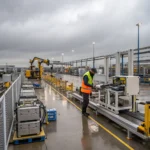In 2025, operational continuity is no longer optional—it's a business imperative. The rise of cyber threats, increasingly complex IT infrastructures, and supply chain uncertainty have made downtime costlier than ever. Traditional disaster recovery (DR) practices, which often rely on rigid, manual procedures and static plans, are proving insufficient in this new era. Enter AI disaster recovery: a transformative approach that blends machine learning, real-time analytics, and intelligent automation to deliver continuous resilience and near-zero downtime.
The Role of AI in Modern Disaster Recovery
AI plays a critical role in transforming legacy DR mechanisms into intelligent, self-optimizing workflows. Predictive analytics allows systems to anticipate risks by analyzing historical performance data, threat intelligence, and usage patterns. This foresight empowers infrastructure to pre-emptively act, often resolving issues before they cause disruption.
AI-driven orchestration takes disaster recovery to a new level. In the event of an outage or performance degradation, AI can initiate failover procedures based on real-time data, ensuring minimal service interruption. Furthermore, real-time anomaly detection powered by machine learning can identify irregularities in system behavior and trigger automated recovery steps without human intervention, accelerating response times and reducing operational overhead.
Unpacking AI Disaster Recovery Workflows for 2025
An AI-driven disaster recovery workflow is distinguished by its ability to sense, analyze, decide, and act autonomously or semi-autonomously. These workflows are built on interconnected layers of automation and intelligence that evolve over time based on data.
Core components include machine learning models for forecasting failure points, orchestration engines for automating failover and backup, and intelligent notification systems that optimize communication during incidents. For example, a cloud-based system might use AI to monitor data replication health. Upon detecting latency or packet loss, it could trigger an auto-failover to a secondary region without manual input, while simultaneously notifying stakeholders and initiating compliance checks.
Designing for Zero Downtime with Intelligent Automation
Zero downtime systems are now achievable through the combination of intelligent automation and resilient infrastructure design. AI enables seamless business continuity by underpinning active-active configurations and Continuous Data Protection (CDP). In active-active architectures, systems run concurrently across multiple sites, and AI ensures they remain synchronized in real time, minimizing the impact of any single failure.
Self-healing systems use AI to detect and remediate issues automatically. If a VM fails or a microservice crashes, AI can invoke scripts or orchestration tools to spin up replacements within seconds. Intelligent workflow automation also ensures routine DR testing—often neglected due to complexity—is conducted frequently through simulated failovers and scheduled drills, validating the entire recovery process without human fatigue or error.
Building Operations Resilience Through AI
AI operations, or AIOps, integrate monitoring, analytics, and automation to strengthen operational resilience. By continuously scanning infrastructure for signs of instability, AI can recommend or enforce changes proactively. For instance, during a sudden traffic spike or hardware failure, AI can reallocate resources and reroute traffic dynamically to maintain performance.
Through dynamic infrastructure scaling, AI ensures that during disruptions—whether from DDoS attacks, cloud provider issues, or internal misconfigurations—workloads are shifted seamlessly to stable environments. Moreover, AI can be embedded into Business Continuity Planning (BCP), ensuring that resilience strategies are not static but evolve in response to internal and external data trends.
Disaster Recovery Automation: Beyond Backups
While backups remain essential, they’re no longer the cornerstone of disaster recovery. AI-powered DR shifts the paradigm from static recovery scripts to event-driven automation. For example, an AI engine can recognize an operational anomaly, determine risk severity, and kick off a pre-tested response plan without waiting for human validation.
Robotic Process Automation (RPA) further accelerates recovery by automating repetitive, cross-system tasks such as data restoration, account verification, and configuration management. Real-world implementations across firms using hybrid cloud environments have shown that AI orchestration can reduce recovery time objectives (RTOs) from hours to minutes through intelligent failover, policy enforcement, and automated ticketing.
The Cloud Advantage: AI-Enabled Disaster Recovery-as-a-Service (DRaaS)
Cloud-native platforms offer scalability and geographical redundancy, but when enhanced with AI orchestration, they become highly adaptive and resilient. With AI-enabled Disaster Recovery-as-a-Service (DRaaS), businesses gain access to automated backup, replication, and recovery solutions without managing complex on-premise DR environments.
AI-enhanced DRaaS solutions such as ConnectWise and Azure Site Recovery provide real-time failure detection, intelligent workload placement, and context-aware recovery routing. This not only allows for faster recovery times but supports region-independent resilience, which is crucial for global operations.
When comparing platforms, it's essential to evaluate the depth of automation, the integration with existing systems, and the ability to learn from previous incidents. The top platforms now integrate AIOps, ML analytics, and customizable recovery orchestration, moving beyond reactive measures to proactive, intelligent DR.
Best Practices for Implementing AI Disaster Recovery
Successful AI disaster recovery begins with aligning DR objectives to business impact analysis. Knowing which systems are mission-critical ensures that AI prioritizes resources and recovery actions effectively.
Continuous learning loops are vital. AI models must be trained and retrained on usage patterns, threats, and past recovery metrics to improve decision-making over time. Comprehensive DR implementations also depend on rigorous, automated testing. AI-driven simulations and compliance audits help ensure that workflows are not only functional but also meet regulatory requirements.
Finally, transparent reporting and documentation generated by AI systems offer invaluable insights for board-level reviews and ongoing planning.
2025 Tech Landscape: Top Tools for AI Disaster Recovery
The market in 2025 is brimming with innovative platforms that embed AI into end-to-end DR automation. ConnectWise automates identification and response workflows across hybrid environments. IBM Watson for DR leverages machine learning to predict systems at risk and suggest optimized recovery paths.
Microsoft Azure AI integrates deeply with its native continuity services, providing anomaly detection and smart orchestration across services. DataRobot, while traditionally used for model deployment, offers new tools for infrastructure risk modeling and adaptive failover strategies.
When evaluating these tools, companies should seek platforms that offer seamless integration with existing tech stacks, adaptable automation layers, and robust support for hybrid or multi-cloud deployments.
Conclusion: Preparing for an Always-On, Zero Downtime Future
As digital infrastructures become more distributed and mission-critical systems are expected to be available 24/7, the importance of AI disaster recovery cannot be overstated. Businesses that adopt intelligent workflow automation today are equipping themselves for a future where downtime is no longer tolerated.
AI not only enhances recovery processes but transforms them into self-sustaining, continually improving systems. In 2025 and beyond, enterprises that prioritize AI-driven DR will lead on reliability, resilience, and customer trust. The time to invest in adaptive, intelligent continuity strategies is now—because in tomorrow’s digital economy, being offline isn’t an option.

![zero-downtime-ai-driven-disaster-recovery-workflows-for-2025-ai-disaster-recovery-ops-resilience-workflow-automation Zero Downtime: AI-Driven Disaster Recovery Workflows for 2025 – [AI disaster recovery, ops resilience, workflow automation]](https://apexworkflows.com/wp-content/uploads/2025/10/make706581661-1024x638.webp)




